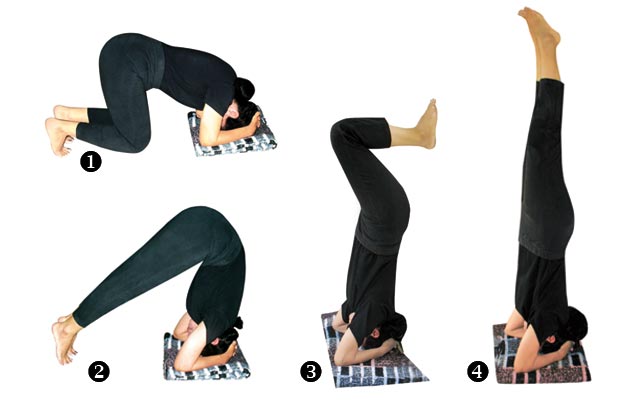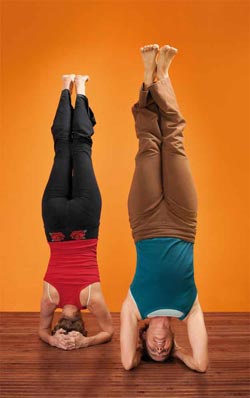Sirsasana or headstand is going upside down against the force of gravity, with the crown of the head grounded on the floor and the legs stretched up. This topsy-turvy position of the body creates an active reversal of the organs, leading to huge anatomical changes. Physically, sirsasana vitalises the cardio vascular, lymphatic, nervous, muscular and endocrine systems. On the mental front, it improves alertness, clarity, concentration, memory, self confidence, emotional stability and happiness.
Getting in the pose:
- Place a folded non-slip yoga mat few inches away from the wall. Cover it with a soft blanket. To get into ardha sirsasana, kneel on the floor, lean forward and place your forearms on the blanket, with elbows shoulder width apart. Interlace your fingers. Your forearms, wrists, and fingers form the framework for the head. Place the crown of your head on the blanket and snuggle the back of the head against your open palms. Focus on grounding your head and stay in this position for 10 – 30 seconds.
- Inhale and straighten your knees, with toes curled in, walk your feet closer to your head. Your hips will be raised and front torso extended. Balance your weight on your head and hands, and lighten your legs. Do not move your head or your hands. Stay steady for few seconds and breathe evenly.
- Exhale and lift both your feet off the floor. When you lift one leg at a time, there is possibility of causing pain in the neck. Bend your legs and place your feet on the wall behind. Adjust and straighten your spine.
- Straighten and stretch your legs towards the ceiling. Rest your hips and legs on the wall. For the first few months of your practice you will need the wall for support. When you develop the control and confidence, you can move your legs gently away from the wall and balance without wall support. When you feel uncomfortable, come out of the pose immediately.

Beginners must practise standing, reclining and semi-inverted asanas for several months to improve awareness, stability and control before attempting sirsasana. Sarvangasana must be practised before sirsasana to strengthen the upper body, remove stiffness from the thighs and hips and improve mind-body control. Props such as the wall, chair and blankets provide better alignment, comfort and balance.
The ancient sages practised sirsasana for 2 –3 hours. But for us modern yogis, sirsasana must be initially practised for 1 – 2 minutes and the time can be gradually extended to 10 minutes depending on your body and mind condition. Most of the weight [about 70 per cent] must be balanced on the head and not on the arms. The arms form the framework for the head. If the weight is on the forearms, muscular tension builds in the arms causing strain and instability. Sirsasana must be learnt and practised with the guidance of a competent yoga teacher.
On regular practice of sirsasana…

- The brain is massaged and flooded with oxygenated blood. Both sides of this vital organ are energised and its functions are enhanced.
- Amrita, the nectar of good health and longevity, is retained in the brain, providing youthful vitality even during old age.
- The heart is completely relaxed as the venous [impure blood] return from the lower half of the body is smooth and steady without stagnation.
- Diaphragmatic breathing during sirsasana generously ventilates the lungs, removing all the blocks from the air passages. It helps to relieve cold, asthma or bronchitis.
- The pituitary and the pineal glands are stimulated and energised. This ensures that they secrete sufficient hormones for the systems to function efficiently. You feel energetic through the day and sleep sound at the night.
- The arteries and veins get relaxed thereby blood flow is smooth and steady in the vessels.
- Exchange of gases, nutrients and waste, between the cells and the blood vessels become more efficient.
- The spine becomes flexible and healthy, abdominal and pelvic organs function well.
- It helps to reduce stress, migraine and tension headaches.
- The digestive fire is increased, toxins are removed, excess body weight is reduced.
- Metabolism increases, ageing slows down and the ill effects of ageing are reduced. It also strengthens the immune system.
- The mind is in the present moment—calm and peaceful. There is no dullness, confusion, anxiety or depression.
- The mood is enhanced—from dullness to freshness, sadness to happiness.
- There is deep awareness, sensitivity, high motivation and will power.
- There is comfort, courage, confidence, contentment, and lasting bliss.
Who should avoid
If you have uncontrolled high blood pressure, retina problems, cataract or conjunctivitis, headache, insomnia or vertigo then avoid this asana. Also due to the anti-gravity nature of the asana it should be avoided during menstruation and pregnancy as well as after aerobic exercise.
Most people find sirsasana difficult because they cannot lift the weight of their thighs and hips against the force of gravity. For many people, the main apprehension in attempting this asana is the fear of going upside down. This fear can be overcome with the guidance of a competent teacher. Sirsasana can uplift your spirits tremendously. So whenever you’re feeling low, just look on the upside!

